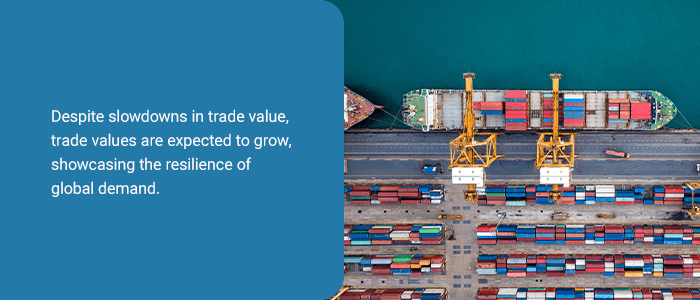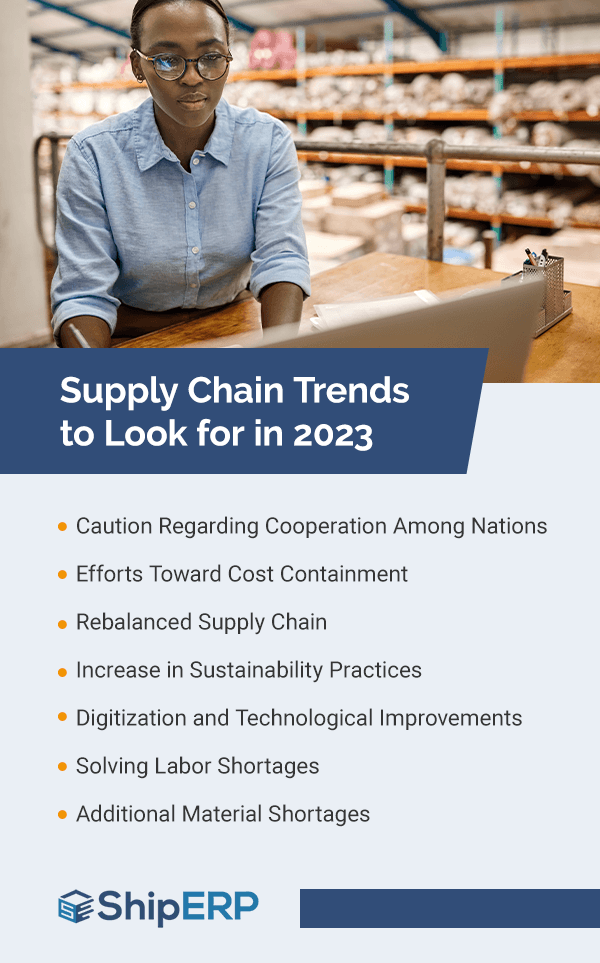There were many predictions for supply chains in 2022, from a recession to difficulties for carrier services. Many of these predictions never came to fruition, but that doesn't mean there weren't challenges for businesses.
Many organizations faced material and labor shortages, shipment delays, and low-profit margins. As a result, enterprises had to make swift changes to sustain customer satisfaction. Learn more about the supply chain lessons learned in 2022 so you can be prepared for 2023.

2022 Supply Chain Lessons
To say supply chains have fluctuated dramatically in the last few years would be an understatement. The COVID-19 pandemic, shutdowns, and global tensions (including the war in Russia and Ukraine) have disrupted supply chains on an unprecedented scale.
In 2022, the challenges facing supply chains were daunting and felt unmanageable (e.g., backorders, shortages, and delivery delays). Limitations from previous years--increased demand and more consumer spending--opened the door for the kinds of supply chain hurdles currently facing many organizations.
There were many lessons learned in 2022 throughout shaky supply chain networks. As a result, many companies have had to adapt by tackling inefficiencies and working smarter. Here are some notable supply chain events that happened in 2022 and how they affected the bottom line:
1. COVID-19 Caused Shipment Delays
Many countries returned to their regular operations in 2022. But there were still countries experiencing lockdowns due to outbreaks, such as China. As a result, many manufacturers experienced shipment delays in 2022, including Dell, HP, and Lenovo.
The lockdowns caused significantly backlogged transportation routes, trapped workers, and thousands of business closures as they waited for official word that they can reopen. The duration of these lockdowns determined the effect on various companies' supply chains.
As of January 2023, China has lifted its COVID-19 lockdown restrictions. As more workers return to work, transportation routes improve, and businesses reopen, shipment delays should decrease, allowing manufacturers to make more products and distribute them to consumers.
2. Manufacturers Faced Shortages
In 2022, many companies faced shortages and could not keep up with demand. Tesla experienced chip shortages, causing CEO, Elon Musk, to announce they wouldn't launch new vehicles in 2022. These shortages forced Tesla to rewrite software to get around chip shortages, reducing the number of chips electric vehicles need to function.
Chip shortages affected numerous other manufacturers as they struggled to keep up with the sudden increase in demand for semiconductors during the pandemic. The ultimate result was a negative impact across various sectors, such as appliances, smartphones, and vehicles. However, Tesla and other tech giants weren't the only ones to experience shortages--foods, baby formula, children's medicine, and fuel were in short supply in 2022 as well. Many of these shortages arose from problems with the global supply chain or international tensions, such as the war between Russia and Ukraine. Baby formula and food shortages also occurred because of recalls and weather impacts on shipping.
Some believed the best way to solve the increase in demand was to strengthen domestic manufacturing capacity, thereby reducing reliance on foreign suppliers (while creating new economic opportunities for Americans at home).
3. Companies Faced Challenges With Revenue
Due to problems in the supply chain and rising material prices, many companies have experienced challenges maintaining their profits. For example, Toyota experienced falling profits, showcasing the difficulties of maintaining performance and margins amid shortages.

Consumer buying habits also changed during and after the pandemic, causing more companies to experience financial strain. More people were shopping online or using curbside pickup, which contributed to reduced profits for numerous brick-and-mortar businesses relying on in-store engagement and impulse purchasing. Some companies turned to layoffs, wage freezes, or increasing product and service prices to compensate for lost profit.
4. Some Supply Chain Problems Were Loosening Up
Many supply chain problems were improving in 2022, such as the cost of a load of timber or transporting shipping containers. However, this wasn't the case for all goods or companies. Various items still experienced delays or high costs compared to pre-pandemic levels. While there have been significant improvements, the global supply network still experiences challenges, and even a single missing component can cause unexpected disruptions.
5. The U.S. Administration Aimed to Protect Supply Chain and Workers
The United States government has made many changes to help protect the supply chain from environmental risks and workers. The administration proposed the Federal Supplier Climate Risks and Resilience Rule, which requires federal contractors to report greenhouse gas emissions and climate-related financial risks.
These contractors must also report their carbon emission reduction targets to ensure they're complying with regulations and meeting goals. These changes will help increase efficiency, improve vulnerability in the supply chain, and reduce climate risks.
Another change the United States made was to improve working conditions, particularly for truckers. The administration's Trucking Action Plan aimed to address working conditions and the number of trucking jobs.
The goal was to help reduce supply chain disruptions and ensure truckers and their families receive the compensation they deserve. Hiring new truckers also helps cut down transportation times, reducing supply chain delays and making production and delivery to consumers easier.
The U.S. Department of Transportation also budgeted $703 million to make way for 41 port improvement projects in 22 states and one territory. The goal of this funding was to help improve supply chain stability across various ports by increasing their capacity, efficiency, and labor opportunities. These projects also aim to reduce emissions and help consumers receive household products sooner.

6. Slowdowns Were Affecting Global Trade
International trade was expected to slow in 2022 due to a weakening global economy and reduced consumer confidence. For example, higher inflation in the U.S. was expected to slow the U.S. economy.
While global trade didn't experience dramatic falls, it still experienced significant slowdowns due to inflation, high energy prices, and rising interest rates. Despite slowdowns in trade value, trade values are expected to grow, showcasing the resilience of global demand.
7. There Were Efforts to Strengthen the Domestic Supply Chain
Due to the challenges sustaining the supply of rare Earth minerals used for technology, the United States unveiled private and governmental steps in 2022 to strengthen our domestic supply, reducing the reliance on China, one of the primary minerals suppliers. This change aimed to help increase the number of goods produced within the country, becoming more independent from other suppliers, so problems within the supply chain occur less frequently.

Supply Chain Trends to Look for in 2023
The supply trends from 2022 inform the supply chain of the future. Below are some shifts to look out for in 2023 to help you prepare for the changes coming to supply chain trends.

Caution Regarding Cooperation Among Nations
Due to global tensions, many nations have experienced skepticism regarding the cooperation and interdependence of the supply chain with other countries. This caution is expected to carry over into 2023 — escalating tensions could cause trade routes to shut down or materials to become inaccessible.
As a result, many governments, including the United States government, are looking for more ways to increase their self-sufficiency in manufacturing and material supply. Countries are also looking into "friend shoring" relationships, which refers to trade relationships with countries nearby or like-minded nations.
People can expect to see the U.S. and other countries shift toward more independence in 2023 and the coming years, whether introducing new legislature or creating a budget to fund manufacturing operations within the country. While the shift toward complete independence and self-sufficiency will take time, many countries are looking to make moves starting in 2023.
Efforts Toward Cost Containment
High inflation and the attempts of the Federal Reserve Bank to control it shaped much of the supply chain industry in 2022 and will continue to do so in 2023. Cost containment rather than growth will be the primary focus for many businesses in 2023. As a result, the supply chain will be under heavy scrutiny this year as companies attempt to get costs under control.
Shippers can reset their strategies and adapt their technologies to take advantage of the excess market capacity. These entities will also look at customer service policies to help reduce transportation costs, helping with containment during an unstable supply chain period.
Rebalanced Supply Chain
Many factors have caused disruptions in the supply chain, including COVID-19 and geopolitical tensions. While U.S. container import volumes are softening, delays and congestions are still a problem. Due to these concerns, global supply chains are rethinking their sourcing strategies going into 2023.
Rather than focusing on optimizing costs, many executives are focusing on agility and resilience. More executives are transitioning to on- or near-shore goods, helping them react better to demand changes without missing valuable opportunities or the ability to access inventory.
Different nations are also implementing incentives to help increase the availability of products and critical materials. This results in executives employing friend-shoring relationships or diversifying their sources beyond the countries or regions they currently get their supply from.
In some cases, these changes may make the supply chain more challenging to manage but more capable of handling market volatility. Rebalancing will create unique circumstances with plenty of competition. Identifying new sources and logistics and manufacturing sources will become essential since alternate sources will quickly consume or raise costs.

Many consumers are becoming more eco-conscious, which is driving their buying decisions. They're choosing companies that are more environmentally friendly or focus on sustainability.
Traditionally, companies have focused on packaging or product sustainability. However, more consumers have been focusing on sustainable logistics options and delivery methods.
Due to these changes among consumers, more last-mile delivery services and retailers are looking to offer more sustainable delivery options in 2023. These alternatives can help increase customer loyalty, capture market share, and reduce delivery costs.
Technological advancements were a significant trend in 2022 and are likely to continue in 2023. Digitization is an excellent way for organizations to address concerns, such as keeping costs down, inflation, and improving customer service.
Digitization shouldn't be confused with automation. Digitization addresses the customer experience, allowing them to receive rates and quotes or book shipments quickly rather than waiting days. Digitization can help organizations make a positive difference in many areas.
On top of digitization, entities are also looking into automation to improve operational and warehouse tasks, helping streamline processes and achieve better supply chain analytics.
Labor shortages have affected every industry, including workers within the supply chain. Even with softening consumer demand, there are still not enough warehouse workers or drivers. Competition for workers occurs in every industry, contributing to supply and demand imbalance. As a result, hiring challenges are expected to continue, especially during peak seasons.
To combat these labor challenges in 2023, logistics companies and shippers are focusing more on automation. Soft automation, in particular, helps existing workers with their jobs. These changes will help workers become more productive and minimize the number of workers needed during high seasons.
The material shortages in 2022 are expected to hit a second wave in 2023. Many organizations may experience limited access to crucial materials, such as spare parts, maintenance items, and critical inputs.
Availability and commodity prices may also fluctuate, whether it's timber, plastic, steel, or fuel. The key to navigating these risks in 2023 is creating resilient supply chains and adapting to new changes as soon as possible.
Addressing material shortages is one of the most important things for organizations to do in 2023. Some ways entities can address these shortages include:
Now that you know what we learned in 2022 regarding supply chain disruptions, you can better prepare for what's expected in 2023. There's plenty of hope for 2023, especially if companies innovate with new technologies and minimize vulnerabilities in the global supply chain.
If you're looking to improve your resilience with supply chain management, ShipERP is here to help. Our add-on enterprise resource planning (ERP) software helps save time and reduce manual work by automating standard processes.








